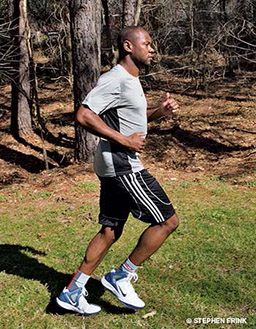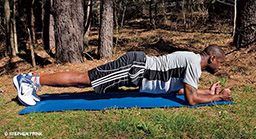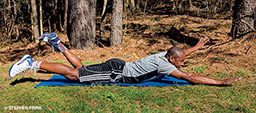Aerobic exercise is the primary recommendation for reducing hypertension, which is associated with an increased risk of cardiovascular disease. One-third of all dive fatalities involve cardiovascular emergencies. Regular participation in aerobic interval training is a great way to proactively promote your enjoyment of the underwater world for years to come.
Aerobic conditioning through cardiovascular circuit training amounts to one-stop shopping for fitness. You gain a variety of benefits in a limited time. The premise is alternating between steady-state (consistent heart rate) cardiovascular training and a variety of higher intensity exercises.
Try to fit in this 23-minute circuit two or three times a day most days of the week. This may mean a single session each day or multiple sessions depending on your schedule and fitness level. The only rest period in the circuit is the transition from one exercise to the next. If you repeat the circuit, rest for two minutes in between. Drink water throughout the workout.
Steady-State Cardio (Five Minutes)

Jog, swim or use any cardio machine in the fitness center — elliptical machines, stationary bikes and steppers are all good options.
Tips for steady-state cardio:
- To raise the intensity while keeping the impact on your joints to a minimum, increase the resistance or the incline rather than the speed.
- Never use your arms to support your body while using a machine. Handrails are for fall prevention, not leaning on. Leaning promotes poor posture, burns fewer calories and may increase the risk of injury.
- Mix it up. Your body will adapt to the exercises you do. Incorporate a variety of cardiovascular activities to maximize effectiveness and eliminate boredom. Vary the cardio within a workout or from one workout session to the next.
- Focus on your breathing. Never hold your breath. If you feel your heart rate increasing, take a deep breath (or a few) to get it under control. You may surprise yourself by not needing to reduce the intensity if you focus on the power of the breath.
Plank (One Minute)

Many variations of the plank have been introduced in previous issues of Alert Diver. The plank is a go-to move because it activates your core musculature for stabilization. This is the natural function of your core in everyday activities, and it is of particular importance during in-water activities such as scuba diving. When you’re submerged, the muscles of your core must function as stabilizers so your limbs can propel you.
- Lie prone (face down) on the floor.
- Support your body with your forearms and toes. You may want to place a towel or mat under your forearms for comfort.
- Focus your eyes on a point on the floor just in front of you.
- Keep your spine straight.
Modification: Support yourself on your knees and forearms. Lie prone, flex (bend) your knees, moving your feet toward your buttocks, and support your body with your forearms and your thighs just above the knees.
Challenge: Add alternating leg raises.
Steady-State Cardio (Five Minutes)
Swimming Arms & Legs (One Minute)

This exercise uses the muscles opposing those used in the plank to balance out the workout.
- Lie prone on the floor with your arms and legs fully extended.
- Continuously alternate lifting your right arm/left leg and your left arm/right leg.
- If possible, do not rest any of your limbs on the floor during the minute.
Steady-State Cardio (Five Minutes)
Body-Weight Sumo Deadlift (One Minute)

This exercise introduces the proper form for the sumo deadlift. Executing this movement using good form will teach your body to recruit the appropriate muscle fibers when you pick up your dive gear, minimizing the risk of injury. It will also stretch your hamstrings, which tend to tighten up after some cardiovascular exercises.
- Stand with your feet comfortably wider than shoulder width and your eyes looking forward.
- Push your hips back, place your hands just above your knees (as if catching your breath), and keep your neck neutral.
- Track your hands from inside your knees straight toward your ankles, trying to touch the floor while bending at the knees and hips.
- Stand up, extending your knees and hips, and squeeze your glutes at the completion of the movement.
Steady-State Cardio (Five Minutes)
You can repeat this cycle for two or three rounds or do each round as an individual training session — it all depends on your current training state and personal schedule. The best cardiovascular workout is the one that will become a regular part of your weekly routine.
Feel free to spice it up by substituting exercises that have been introduced in previous issues of Alert Diver. Just be sure to focus on form and have fun.
DAN Note: To avoid an increased risk of decompression sickness, DAN recommends that divers avoid strenuous exercise for 24 hours after making a dive. During your annual physical exam or following any changes in your health status, consult your physician to ensure you have medical clearance to dive.
© Alert Diver — Q2 Spring 2014